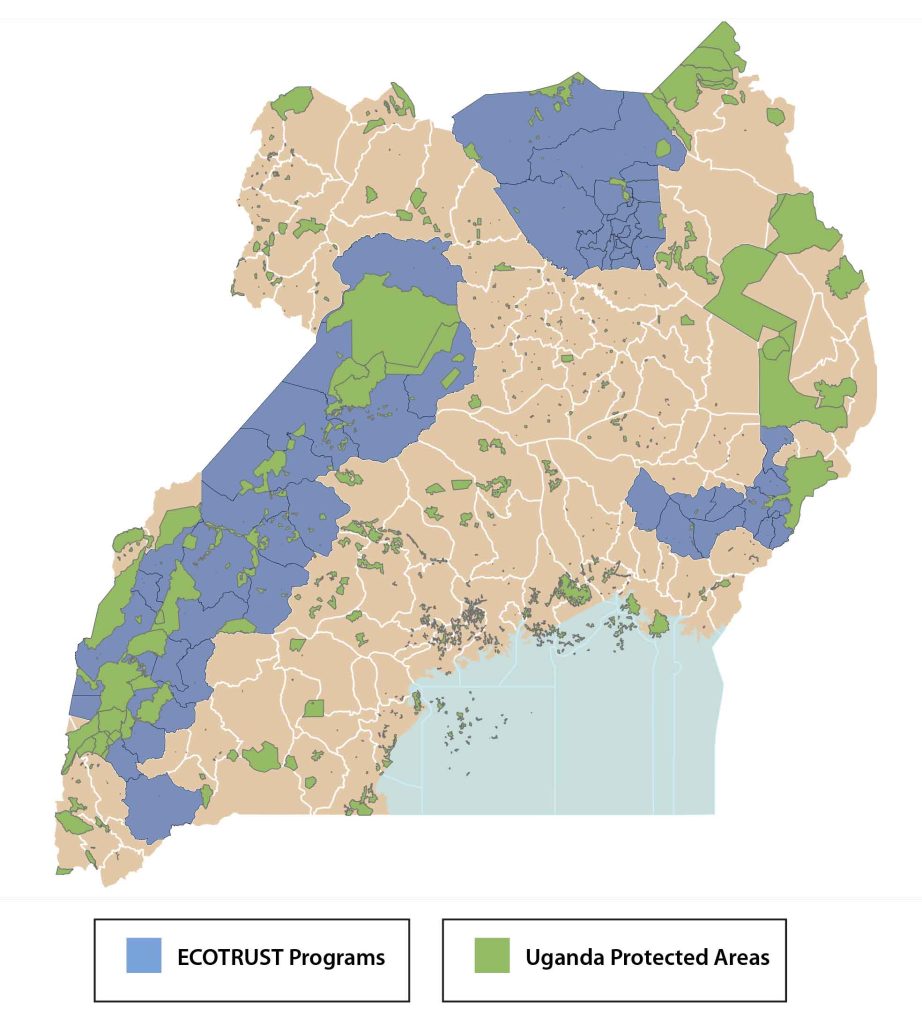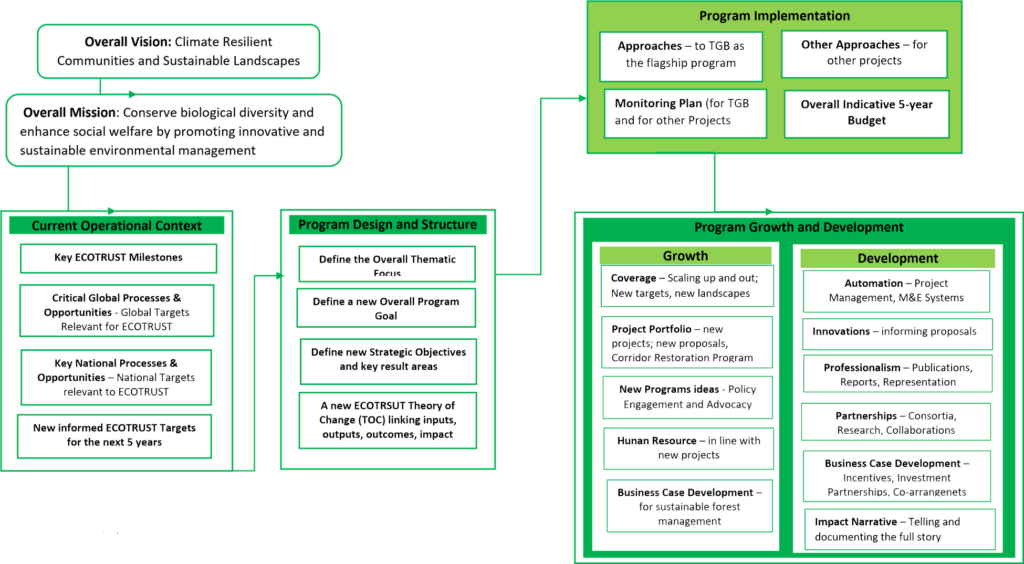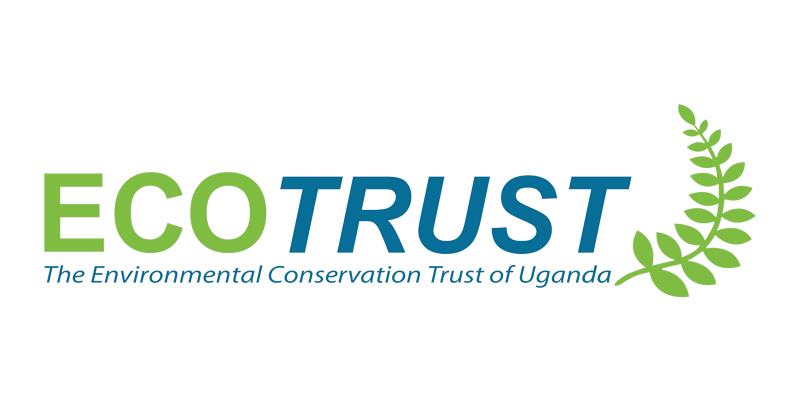Our Progammes

Program Locations
ECOTRUST operates across Uganda with a focus on three main landscapes: Queen Elizabeth National Park landscape and Murchison-Semliki landscape in the Albertine region of South-Western Uganda, and the Mount Elgon Landscape in Eastern Uganda. These are all landscapes of global biodiversity significance, but they are also hot spots for climate change induced disasters – especially floods, mud slides and changing weather patterns that result in frequent and unexpected droughts and changes in rainy seasons.
The map shows the spatial coverage of ECOTRUST vis-à-vis the key biodiversity areas in Uganda. ECOTRUST programs in these areas are currently supporting 12,000ha of land under improved forest management by approximately 10,000 smallholders linked to the voluntary carbon market.
Over the next -5 year strategic period (2026-2022), we would like to scale out our programs to the Northern Region (15,000ha), Lake Victoria Basin (15,000ha), South Kigezi Sub-region (15,000ha) and Eastern Region (15,000ha) – a total of 60,000ha over 5 years. Expansion to Mpologoma landscape in Eastern Uganda is already underway.
Our Program Strategy
Efficient and effective program design and delivery with measurable results and sustainable impact in target communities and landscapes defines our success.
Program delivery is at the core of ECOTRUST existence. Efficient and effective program design and delivery with measurable results and sustainable impact in target communities and landscapes defines our success. The program strategy for the next 5 years (2022-2026) builds upon the achievements of the previous period (2017-2022) and the over 20 years of experience that ECOTRUST brings since inception in 1999. The program strategy defines our program aspirations and desire to succeed. It defines our focus – trimming our ambitions to match our resources – and articulating our best practices that we need to take advantage of and sustain. The new program strategy will also enable us to define some new stretch targets that will force us to compete in innovative ways and accelerate the pace organizational learning, as well as attain seemingly impossible new levels professionalism and leadership. The program strategy defines 3 main features: Program Design and Structure, Program Implementation and Management, and Program Growth and Development.
ECOTRUST Program Strategy

- Key International & National Policies
Our Programs Draw from Key International & National Policies
We are responsive to the National Sustainable Development Agenda such as Uganda’s National Adaptation Program of Action (NAPA), the National Climate change Policy (NCCP), the National Development Plan (NDP III), Uganda’s Green Growth Development Strategy; Climate Change Bill; Vision 2040, and SDGs 15, 13, 16, 7, 6, 5, 2 & 1. Our programing over the outgoing strategic period (2017-2021) has been aligned to the global and national sustainable development, biodiversity conservation and climate change agendas.
- National policies and guidelines.
ECOTRUST ensures optimal participation of all key stakeholders, including District Local Governments, CSOs and CBOs in all the operational districts across Uganda
We draw from Uganda’s National Adaptation Program of Action (NAPA) that prioritizes community tree growing; land degradation management; drought adaptation, climate change and development planning.
National Climate change Policy (NCCP) – provides a harmonized approach towards a climate-resilient and low-carbon development path. Adaptation sectors include Forestry, Wetlands, Biodiversity, Ecosystem services, Human settlement, and social infrastructure; disaster risk management (and technology transfer; and scaling out of clean low carbon technologies).
National Development Plan (NDP III) 2020/21 – 2024/25 – prioritizes addressing the widespread forest loss and forest degradation across the country for sustained economic growth and long-term human development – UGANDA’S VISION 2040
The Uganda Wildlife Act, 2019 – provides for the conservation and sustainable management of wildlife. Contains sections addressing wildlife conservation areas; protected species; wildlife use rights; hunting and trapping; management of problem animals; and international trade in species and specimens.
ECOTRUST programs are also in line with the Common Refugee Response Framework (CRRF) in Uganda and the Water/Environment Sector Response Plan which aim to increase environmental protection and forest restoration and improve sustainable energy use by displaced populations and their host communities.
ECOTRUST programs are being implemented in line with the Uganda Forestry Policy of 2001 which promotes the development and sustainable management of natural forests on private land. The policy encourages the development of collaborative partnerships with rural communities for the sustainable management of forests. It promotes the growing of trees on-farm in all farming systems. The policy affirms GOU support for sustainable forest sector development through appropriate education, training and research.
Land Act (Cap. 227) – makes provision with respect to a wide variety of matters regarding land in Uganda such as land tenure, customary ownership, grant of land in freehold, management of communal land, management of land by the Uganda Land Commission, landuse control and functioning of land tribunals.
Green Growth Development Strategy – provides mechanisms through which Uganda will deliver upon its national and international commitments especially the Uganda National Climate Change Policy (2013) and the Paris Climate Agreement,
The National Environment Act, 2019 – repeals, replaces and reforms the law relating to environmental management in Uganda. Provides for the management of the environment for sustainable development.
Provides for emerging environmental issues including climate change. Provides for biodiversity offsets and strategic environmental assessment. Addresses environmental concerns arising from petroleum activities and midstream operations
National Forest and Tree Planting Act, 2003 – provides for the conservation, sustainable management, and development of forests for the benefit of the people of Uganda. Provides for the declaration of forest reserves for purposes of protection and production of forests and forest produce. Provides for the sustainable use of forest resources and the enhancement of the productive capacity of forests. Provides for the promotion of tree planting and trade in forest produce. Provides for conservation of biological diversity, and the devolution of functions and powers in the forest sector
Uganda’s Vision 2040 – aspires to raise the forest cover from 15% in 2010 to 24% in 2040 and recognizes Uganda’s unique environmental endowment, which is largely constituted by its water resources and wetlands, biodiversity and ecosystem health, land resources, fisheries resources, forests, and minerals.
The REDD+ Process in Uganda – Initiated at UNFCCC COP16 calls on all participating countries to (a) Reduce emissions from deforestation; (b) Reduce emissions from forest degradation; (c) Conserve Forest carbon stocks; (d) Sustainably manage forests; and (e) enhance forest carbon stocks. To achieve these goals, Uganda has developed a national REDD+ strategy that determines a national forest reference emission level
- International Processes and Opportunities
ECOTRUST programing over the outgoing strategic period (2017-2021) has been aligned to the global and national sustainable development, biodiversity conservation and climate change agendas. ECOTRUST programs seek to contribute to the proposed targets and outcomes where it matters most – and influence, in whatever small way, the overall implementation for the benefit poor rural communities. Below are the key international processes and opportunities that will influence ECOTRUST programing over the next period.
SDG 15 specifically calls for the protection, restoration, and promotion of sustainable use of terrestrial ecosystems, sustainably manage forests, combating desertification, and halting and reversing land degradation and halting biodiversity loss. SDGs 13, 16, 7, 6, 5, 2 & 1.are also critical.
Target 15.2 seeks to ensure that by 2020, the implementation of sustainable management of all types of forests, halt deforestation, restore degraded forests, and increase afforestation and reforestation globally.
Target 15.b seeks to significantly mobilize resources from all sources
and at all levels to finance sustainable forest management and provide adequate incentives to developing countries to advance sustainable forest management, including for conservation and reforestation.
The Bonn Challenge is a global effort to bring 150 million hectares of the world’s deforested and degraded land into restoration by 2020, and 350 million hectares by 2030. FLR is a process that restores ecological integrity while at the same time improving human well-being through multifunctional landscapes
The 2020 target was launched at a high-level event in Bonn in 2011 by the International Union for Conservation of Nature (IUCN) and the Government of Germany and was later endorsed and extended to 2030 by the New York Declaration on Forests of the 2014 UN Climate Summit.
In September 2014, Uganda committed to the Bonn challenge by pledging to restore 2.5 million hectares of previously deforested and/or degraded areas. It is estimated that with the successful restoration Uganda could realize as much as USD$ 785 million while at the same time sequestering 0.24 Gigatons of Carbon dioxide equivalent.
The UN Convention on Biological Diversity (CBD) Secretariat on 12 July 2021 released the first official draft of a new Global Biodiversity Framework to guide actions worldwide through 2030 to preserve and protect nature and its essential services to people. Vision: Living in Harmony with Nature
Goal 1: The integrity of all ecosystems is enhanced, with an increase of at least 15% in the area, connectivity and integrity of natural ecosystems, supporting healthy and resilient populations of all species
Goal 2: Nature’s contributions to people have been valued, maintained, or enhanced through conservation and sustainable use supporting the global development agenda for the benefit of all.
Goal 3: The benefits from the utilization of genetic resources are shared fairly and equitably
Goal 4: The gap between available financial and other means of implementation closed
The 2015 Paris Agreement requires each country to outline and communicate their post-2020 climate actions, known as their nationally determined Contributions (NDCs), for reducing greenhouse emissions.
Reducing emissions from deforestation and forest degradation and the role of conservation, sustainable management of forests and enhancement of forest carbon stocks in developing countries (REDD+) is a framework negotiated under the UNFCCC to facilitate intergovernmental cooperation on forests and climate change.
Forests are vitally important for achieving the goals of the Paris
Agreement, and the REDD+ framework is therefore recognized in Article 5 of the Paris Agreement. The Convention requires all Parties, keeping in mind their responsibilities and capabilities, to formulate and implement programmes containing measures to mitigate climate change.
Sites that contribute significantly to the global persistence of biodiversity – 11 criteria grouped under five categories which can apply to all taxonomic groups (i.e., species) as well as ecosystems
1.Threatened biodiversity: The site holds species at risk of extinction or ecosystems at risk of collapse
Geographically restricted biodiversity: species or ecosystems found in only a few other places on Earth or, sometimes, nowhere else.
Ecological integrity: The site remains ecologically intact, unaffected by industrial human influence
Irreplaceability: high irreplaceability for the global persistence of biodiversity. Biological processes: The site holds a significant proportion of a species’ population during one or more of its life stages (e.g., during nesting), making it important for that species’ continued survival.
- OUr strategic objectives
Our Strategic Objectives and Key Result Areas
Our overall goal over the next period will be: “Enhanced livelihoods, adaptive capacity and mitigation potential of 16.5 million people in partner communities and landscapes in 33 Districts of Uganda by supporting smallholder-led reforestation, restoration and improved management of at least 60,000ha of degraded land, over the next 5 years”. This goal will be achieved through the following strategic objectives:
STRATEGIC OBJECTIVE 1
Market-Based Incentives to Promote Smallholder-Led Forest Landscape Restoration (FLR) As a Business (RAAB) Delivered
STRATEGIC OBJECTIVE 2
Investment Partnerships with Private Forest Owners, Government, Communities and Other Stakeholders to Ensure Protection of Functional Habitat Connectivity and Contribution to Sustainable Livelihoods
STRATEGIC OBJECTIVE 3
Co-Financing Arrangements to Protect the Ecological Integrity and Functionality of Natural Capital in Protected Areas and Other Effective Area-Based Conservation Measures (OECMS) to Generate Goods and Services that Benefit Local Communities and Biodiversity
STRATEGIC PLAN 2022 - 2026
Download a copy of our strategic framework document for the period 2022 – 2026 using the link below


Follow Us On